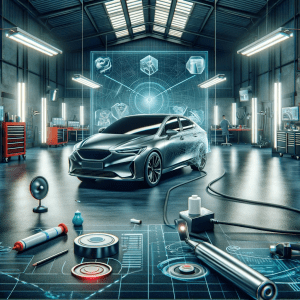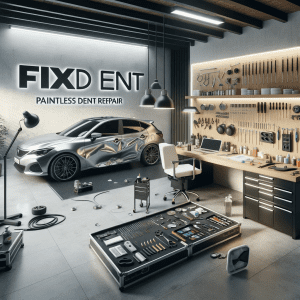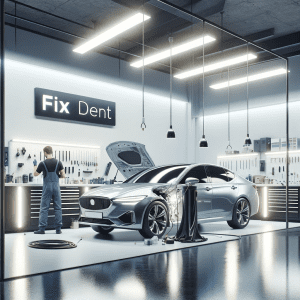 In the current era of innovation, the automotive industry is constantly seeking ways to optimize and improve repair processes. Effective body repair is not just a matter of aesthetics, but also essential for preserving the value and safety of the vehicle. Among the variety of repair methods, Paintless Dent Repair (PDR) emerges as a modern alternative to traditional approaches. This article provides an in-depth analysis of the PDR method compared to traditional techniques, examining their differences, advantages, and limitations.
In the current era of innovation, the automotive industry is constantly seeking ways to optimize and improve repair processes. Effective body repair is not just a matter of aesthetics, but also essential for preserving the value and safety of the vehicle. Among the variety of repair methods, Paintless Dent Repair (PDR) emerges as a modern alternative to traditional approaches. This article provides an in-depth analysis of the PDR method compared to traditional techniques, examining their differences, advantages, and limitations.
I. Basics of PDR (Paintless Dent Repair)
PDR, or paintless body repair, is a technique increasingly popular among automotive services due to its efficiency and economic benefits. This method involves using specialized tools and techniques to gently massage the metal from the back of the bodywork, restoring the original shape without altering the paint and coating.
To understand the true value of PDR, it is important to look at its origins. The development of PDR began with the need to offer faster and less invasive repair solutions for minor body damage, such as dents from hail or light bumps in parking lots. This method has become popular over the last few decades, establishing itself as the preferred choice for many situations.
The PDR process requires not only skills and experience but also precision. Technicians use lights or reflectors to identify the exact location of the defect, then with specific tools, push or “massage” the metal back into its original shape. This is an art that requires patience and sensitivity – qualities that definitely distinguish professionals from amateurs in this field.
Considering PDR in the context of traditional repair methods, it becomes evident that it offers several advantages, but also has its limitations. The main question to be examined is when and why PDR is the preferred choice, and in which cases traditional approaches remain inevitable.
II. Traditional Body Repair Methods
Unlike PDR, traditional body repair usually involves comprehensive procedures, which can vary from filling dents with fillers, sanding and applying a base, to painting and varnishing. This approach is often necessary for more significant damage, where PDR would not be effective, or in cases where the paint has already been damaged.
Traditional repair requires considerable time resources, as each stage of the process must be performed carefully to ensure a quality finish. The initial assessment of the damage often involves dismantling the corresponding parts of the bodywork to access the dent area. Then, the metal surface must be prepared – this may include shaping the metal and filling irregularities with a special filler. Once the filler dries, the surface is sanded to achieve a smooth finish. The application of the base and paint is a complex process requiring specialized equipment and conditions to avoid paint contamination and ensure a long-lasting finish.
Traditional methods are preferred for more complex repairs that require the restoration of the vehicle’s structural integrity or the replacement of parts. However, they lead to higher labor and material costs, as well as a longer repair period, which can be inconvenient for vehicle owners.
III. Comparative Analysis
When comparing Paintless Dent Repair (PDR) to traditional methods, it’s important to examine several key areas. The preparation for repair with PDR is considerably faster, as there is no need to dismantle parts or use fillers and paint. The process is much less invasive and allows vehicles to return to the road more quickly.
Working with the tools themselves requires specialized training and experience – PDR technicians must have a developed sensitivity for the metal and be able to read reflections to properly assess the dent. However, when performed correctly, PDR leaves the metal surface intact, which is a key advantage in preserving the original paint and protective coating of the car.
The completion of traditional repair requires much more time and materials, including drying time for the paint and fillers, as well as additional checks to ensure that the new paint matches the original exactly. This can also include reassembling parts of the car, which is an additional time-consuming process.
IV. Advantages of PDR


One of the biggest advantages of PDR is that the method is faster and less costly compared to traditional methods. As painting is not required, it saves hours of preparation, sanding, and drying. This not only reduces material costs, such as paint and fillers, but also allows vehicles to leave the workshop much faster, which is convenient for customers.
Moreover, PDR preserves the original paint and coating of the car, which is extremely important in maintaining its market value. It’s no secret that cars with original factory paint are valued higher upon resale. This is particularly crucial for collector and luxury cars, where even small details can have a significant impact on the overall value.
The environmental aspect of PDR is also an important factor. Traditional repair often involves chemicals and solvents harmful to the environment. PDR is a cleaner and safer method, as it avoids these toxic materials, making it the preferred method for more and more workshops looking to adopt “green” practices.
V. Limitations and Disadvantages of PDR
Despite its many advantages, PDR is not a universal solution for all types of damage. The main limitation of the method is that it is only suitable for dents where the paint is not compromised. If the coating is damaged, traditional repair becomes inevitable.
Another limitation is that PDR requires access to the back of the dent, which can sometimes be difficult if the damage is located in a hard-to-reach area. Additionally, larger or more complex dents may require more time and skills, which can increase the cost and reduce the economic advantage of using PDR.
Finally, the quality of PDR can vary significantly depending on the technician’s skills. This means that to achieve the best results, it is necessary to hire highly qualified specialists, which can be a challenge for workshops.
VI. When to Opt for PDR and When for Traditional Repair
The choice between PDR (Paintless Dent Repair) and traditional repair depends on several factors. PDR is the ideal choice for small to medium-sized dents that have not affected the paint. These types of damages often occur due to hail, light collisions with other vehicles, or minor parking incidents.
On the other hand, traditional repair is necessary when significant metal damage requires a complete overhaul or replacement of parts. This includes cases of serious accidents where the structural integrity of the car is compromised, or when the damage is so extensive that PDR would not be effective.
In conclusion, PDR offers several advantages and is a revolutionary method for dent repair, while having its limitations. Understanding when and how to apply this method is essential for garages wishing to provide the best service to their clients.




